| SU45 | |||||||||||||||||||||||||||||||||||
|---|---|---|---|---|---|---|---|---|---|---|---|---|---|---|---|---|---|---|---|---|---|---|---|---|---|---|---|---|---|---|---|---|---|---|---|
 SU45-079 locomotive at Wrocław Główny railway station | |||||||||||||||||||||||||||||||||||
| |||||||||||||||||||||||||||||||||||
| |||||||||||||||||||||||||||||||||||
| |||||||||||||||||||||||||||||||||||
| |||||||||||||||||||||||||||||||||||
SU45 is a Polish diesel locomotive. It had been made for universal use: heavy transport or passenger transport alike.
| SU45 | |||||||||||||||||||||||||||||||||||
|---|---|---|---|---|---|---|---|---|---|---|---|---|---|---|---|---|---|---|---|---|---|---|---|---|---|---|---|---|---|---|---|---|---|---|---|
 SU45-079 locomotive at Wrocław Główny railway station | |||||||||||||||||||||||||||||||||||
| |||||||||||||||||||||||||||||||||||
| |||||||||||||||||||||||||||||||||||
| |||||||||||||||||||||||||||||||||||
| |||||||||||||||||||||||||||||||||||
SU45 is a Polish diesel locomotive. It had been made for universal use: heavy transport or passenger transport alike.

This locomotive is in fact a SP45 with a modified heating system – a steam boiler was replaced by an electric heating system. During 2010 4 locomotives were rebuilt to class ST45.
Currently, there are three SU45 locomotives in operation. Vehicles number 143 and 194 operate freight depots, and vehicle number 079 was repaired in 2022 and returned to service. It is stationed in Wrocław and runs tourist passenger trains. Currently, it is planned to restore vehicle number 228 purchased by the Association of Railway Enthusiasts in Chojnice from PKP Cargo to traffic. The vehicle is to be renovated and used to operate tourist passenger trains.
| Locomotives numbers | Producer | Production years | Quantity |
|---|---|---|---|
| 001 - 268 | modification of SP45 | 1987–1998 | 191 |
These locos used to be called by the following names:

A locomotive or engine is a rail transport vehicle that provides the motive power for a train. If a locomotive is capable of carrying a payload, it is usually rather referred to as a multiple unit, motor coach, railcar or power car;

VR-Group Plc, commonly known as VR, is a government-owned railway company in Finland. VR's most important function is the operation of Finland's passenger rail services with 250 long-distance and 800 commuter rail services every day. With 7,500 employees and net sales of €1,251 million in 2017, VR is one of the most significant operators in the Finnish public transport market area.

An electric locomotive is a locomotive powered by electricity from overhead lines, a third rail or on-board energy storage such as a battery or a supercapacitor. Locomotives with on-board fuelled prime movers, such as diesel engines or gas turbines, are classed as diesel-electric or gas turbine-electric and not as electric locomotives, because the electric generator/motor combination serves only as a power transmission system.

The British Rail Class 47 or Brush Type 4 is a class of diesel-electric locomotive that was developed in the 1960s by Brush Traction. A total of 512 Class 47s were built at Brush's Falcon Works in Loughborough and at British Railways' Crewe Works between 1962 and 1968, which made them the most numerous class of British mainline diesel locomotive.

The British Railways Class 24 diesel locomotives, also known as the Sulzer Type 2, were built from 1958 to 1961. One hundred and fifty-one were built at Derby, Crewe and Darlington, the first twenty of them as part of the British Railways 1955 Modernisation Plan. This class was used as the basis for the development of the Class 25 locomotives.
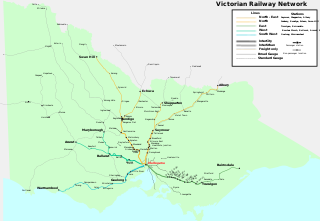
Rail transport in the Australian state of Victoria is provided by a number of railway operators who operate over the government-owned railway lines. The network consists of 2,357 km of Victorian broad gauge lines, and 1,912 km of standard gauge freight and interstate lines; the latter increasing with gauge conversion of the former. Historically, a few experimental 762 mm gauge lines were built, along with various private logging, mining and industrial railways. The rail network radiates from the state capital, Melbourne, with main interstate links to Sydney and to Adelaide, as well as major lines running to regional centres, upgraded as part of the Regional Fast Rail project.
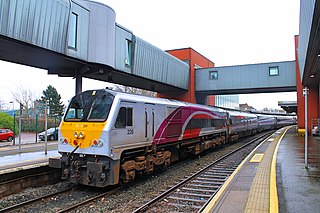
The Iarnród Éireann (IÉ) / Northern Ireland Railways 201 Class locomotives are the newest and most powerful diesel locomotives operating in Ireland and were built between 1994 and 1995 by General Motors Diesel. They are model type JT42HCW, fitted with an EMD 12-710G3B engine of 3,200 hp (2,400 kW), weigh 108.862 tonnes and have a maximum speed of 164 km/h (102 mph).

The British Rail Class 37 is a diesel-electric locomotive. Also known as the English Electric Type 3, the class was ordered as part of the British Rail modernisation plan. They were numbered in two series, D6600–D6608 and D6700–D6999.

The Victorian Railways (VR), trading from 1974 as VicRail, was the state-owned operator of most rail transport in the Australian state of Victoria from 1859 to 1983. The first railways in Victoria were private companies, but when these companies failed or defaulted, the Victorian Railways was established to take over their operations. Most of the lines operated by the Victorian Railways were of 5 ft 3 in. However, the railways also operated up to five 2 ft 6 in narrow gauge lines between 1898 and 1962, and a 4 ft 8+1⁄2 instandard gauge line between Albury and Melbourne from 1961.

In rail transport, head-end power (HEP), also known as electric train supply (ETS), is the electrical power distribution system on a passenger train. The power source, usually a locomotive at the front or 'head' of a train, provides the electricity used for heating, lighting, electrical and other 'hotel' needs. The maritime equivalent is hotel electric power. A successful attempt by the London, Brighton and South Coast Railway in October 1881 to light the passenger cars on the London to Brighton route heralded the beginning of using electricity to light trains in the world.

The British Rail Class 20, otherwise known as an English Electric Type 1, is a class of diesel-electric locomotive. In total, 228 locomotives in the class were built by English Electric between 1957 and 1968, the large number being in part because of the failure of other early designs in the same power range to provide reliable locomotives.

SU46 is the name for a diesel universal purpose locomotive working for Polish PKP. Cegielski has produced 52 machines in years 1974-1977 and 2 modified in 1985.

SP42 is the name for a Polish diesel locomotive used for passenger services.

SU42 is a Polish diesel-electric locomotive used for light freight and passenger traffic purposes.

ST43 is the name for a Romanian diesel locomotive, produced by Electroputere, exported to and operating in Poland. It was made for the purpose of heavy transport.

SP45 is the name for a Polish diesel locomotive. It was built for the purpose of passenger traffic. No operating examples of this loco remain. All have been phased out or rebuilt into SU45.
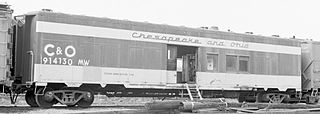
A steam generator is a type of boiler used to produce steam for climate control and potable water heating in railroad passenger cars. The output of a railroad steam generator is low pressure, saturated steam that is passed through a system of pipes and conduits throughout the length of the train.
The South Gippsland Railway was a tourist railway located in South Gippsland, Victoria, Australia. It controlled a section of the former South Gippsland railway line between Nyora and Leongatha, and operated services from Leongatha to Nyora, via Korumburra, the journey taking about 65 minutes.
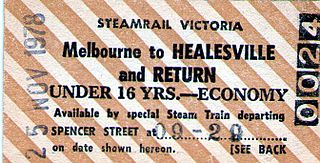
The Healesville railway line, in Melbourne, Australia, was the non-electrified continuation of the suburban Lilydale line, extending into the Yarra Valley. The line closed in the 1980s, but a heritage railway group, the Yarra Valley Railway, is working to retain part of the line between Yarra Glen and Healesville.
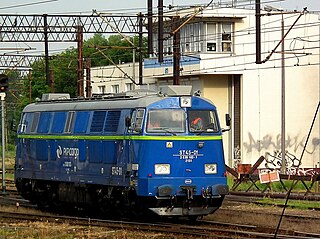
ST45 is the name for a Polish diesel locomotive. They are freight only locomotives, having had their train heating removed.